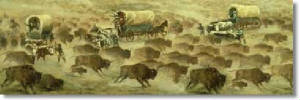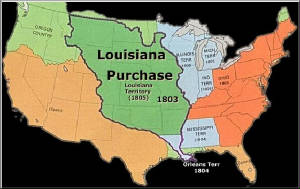|

|
| http://www.isu.edu/~trinmich/Buffallo.html |
Native Americans have existed in the West for several centuries, far before the
whites came in and took over. Peace and trade alliances existed among these peoples. They protected the hunting domains because
it was very important to their economy. The West provided the Natives with many rich resources and nonetheless helped them
live comfortably. North American Indians shared their world with buffalos, bear, wolves, eagles, antelopes, and even deers.
Early expansion of the new United States to the west completely changed the lives of many Native Americans as whites moved
in. Most definitely, the Louisiana Purchase, the Oregon Trail, and the way the U.S. government acted distorted the lives of
millions of Natives. The American Indian almost disappeared just in the same way the buffalos did. (http://www.pbs.org/wgbh/amex/tcrr/sfeature/sf_interview.html#a)
About less than a thousand buffalos were left by the 20th century as the land hungry settlers entered the West
that the Natives kept under control. Not only did the whites take their land but they also left them hungry as they killed
many buffalos.

|
| http://thomaslegion.net/sitebuildercontent/sitebuilderpictures/louisiana_purchase_treaty_agreement.j |
The Louisiana Purchase consisted
of the United States purchasing the Louisiana Territory from France at a price of $15 million. This particular purchase became
a responsibility of Thomas Jefferson and doubled the size of the U.S. This opened up a westward expansion for the white settlers.
However, at this time people were already living in these parts, and of course they were the Native Americans. At this time
there were seven important tribes living in the area; the Attakapa, the Caddo, the Tunica, the Natchez, the Muskhogean, the
Chitimacha, and the Cherokees. As Europeans moved into Mississippi, Alabama, and Tennessee two other important groups of Native
Americans migrated into Louisiana. The Biloxi who came from the coast between Mobile Bay and New Orleans and the Choctaws
who moved into Louisiana and settled along the west bank of the Mississippi River .Even though Native American people were
already in the area, Lewis and Clark, the two explorers of the new, bought land, made it clear that the territory was to be
opened for European settlement. Jefferson did not wish to get the Natives off the land but either wanted them to move further
into the west or become civilized. He even wanted to set up a constitutional amendment that guaranteed Native Americans rights
to land in West but instead that did not happened and quickly the Native Americans were forced off land instead of getting
off voluntarily. (Torr) By the 1820s, even the U.S. troops were forcibly removing some tribes who wanted to remain in their
long-established homelands.
By the 1830s most tribes relocated, but
the two that remained were the Cherokees and the Choctaws. However, with the involvement of the U.S. government, their resistance
did not last. Andrew Jackson came up with the Indian Removal Act that gave him
the power to remove the Natives. By 1837, the Jackson administration had removed 46,000 Native American people from their
land east of the Mississippi and sent the Cherokees on a death march known as Trail of Tears. During this long journey they
faced hunger, disease, and exhaustion. Over 4,000 out of 15,000 of the Cherokees died. (http://www.pbs.org/wgbh/aia/part4/4p2959.html)
The Cherokee nation was one of the "Five Civilized Tribes" in the southeast but to benefit the whites, Andrew Jackson planned
their removal along with all other tribes existing east of the Mississippi River. (Taylor) However, the civilized tribe tried
to fight back against Jackson both in 1831 with the case Cherokee Nation
v. Georgia but the Supreme Court denied them self-government. In 1832 however,
John Marshall allowed the rights to land for the Cherokee nation in the case Worcester v. Georgia. This did not stop Andrew
Jackson and he simply stated, “"John Marshall has made his decision, now let him enforce it.” (Lewis)
"I saw the helpless Cherokees arrested
and dragged from their homes, and driven at the bayonet point into the stockades. And in the chill of a drizzling rain on
an October morning I saw them loaded like cattle or sheep into six hundred and forty-five wagons and started toward the west..”
(Private John G. Burnett, Torr)
Nonetheless, Jackson went against the constitution and went beyond
his presidential powers to force the Native Americans out of the land he wanted white settlers to have even if they were a
civilized tribe such as the Cherokee. He did not only did he go against rules, but he also went against humanity as he lead
many Natives to their death instead of new land.
|
|
| http://www.thefurtrapper.com/oregon_trail.htm |
The Oregon-California trail also became
a nightmare for the Natives. This trail became a 2,170 mile route from Missouri to Oregon and California and it was a way
for pioneers to move westward for both land and for gold. The first emigrants took the trip in 1836 and were known as make
the Marcus and Narcissa Whitman. The first major migration occurred around 1843 and it was believed that around 1000 pioneers
made the journey at one time. (Underwood) During this time it seemed peaceful between the Natives and the new settles and
they usually encountered in simple trades. However, even this peace soon ended as the Grattan Massacre took place in 1854
near Ft. Laramie. A small incident such as a single cow wandering away from an
expatriated wagon train and going into a Sioux village where they ate it led to a massacre. An aggressive Lt. Grattan and
28 men then left Fort Laramie with a single objective to punish the Sioux. The Sioux offered a horse in return for the cow,
but Grattan refused and fired upon the innocent tribe. Another massacre occurred
in the early 1860s known as the Bear Massacre with Patrick Conner, stationed in Salt Lake City. He wanted to teach
the Native Americans a lesson and in January of 1863, he and his Californian Volunteers marched north to the Bear River. There,
Conner's men brutally killed 400 Shoshoni men, women and children. (Wissler) Even at the beginning of the Oregon trail many
natives offered a hand to the distraught emigrants but the only things that the new settlers left for the Natives were mass
number of buffalo skeletons.
"The valley of the Platte for 200 miles; dotted with skeletons of buffalos; such a waste of the creatures God had made
for man seems wicked, but every emigrant seems to wish to signalize himself by killing a buffalo." (Emigrant Isaac
Foster, http://www.isu.edu/~trinmich/Buffallo.html)
The Oregon Trail was safe for a while,
but soon the brutal attacks from the white settlers angered the Native Americans and they soon began to rebel as well. Land
hungry settlers and the natives who wanted their land soon began a quarrel, but fortunately there was no extreme war between
the two groups.
Furthermore, the west expansion might
have opened a lot more land for the white settlers to do more farming and to even bring in slavery into the new territory
but it also meant the worst for the Natives. They were being kicked out of places they have lived for many years. The places
they once called homes were now being taken over by people who did not even know what the land had to offer. Through the Louisiana
Purchase, the Oregon Trail, and the actions of the U.S. government, the Natives became unimportant and were forced to get
off lands that indeed belong to them.
Works Cited
"American Experience/ Special Features." PBS. 26 May 2009 <http://www.pbs.org/wgbh/amex/tcrr/sfeature/sf_interview.html#a>.
"Buffalo on the Oregon-Trail." Idaho State University. 26 May 2009 <http://www.isu.edu/~trinmich/Buffallo.html>..
"Indian removal." PBS. 25 May 2009 <http://www.pbs.org/wgbh/aia/part4/4p2959.html>.
Lewis, Chris. "American Indians and the Struggle for the West." University of Colorado at Boulder. 26
May 2009 <http://www.colorado.edu/AmStudies/lewis/2010/indians.htm>.
Taylor, Jim. "Native American History in Arkansas - Part 1." Bull Shoals Lake Arkansas - South Shore.
26 May 2009 <http://www.southshore.com/louisianapurchase.htm>.
Torr, James D. Indigenous Peoples of North America - Primary Sources (Indigenous Peoples of North America).
New York: Lucent Books, 2002.
Underwood, Todd "Oregon Trail History." Frontier Trails - Adventures in History. 26 May 2009 <http://www.frontiertrails.com/oldwest/oregontrail.htm>.
Wissler, Clark. Indians of the United States. New York: Anchor Books, 1989.
|

